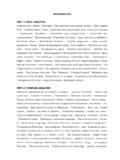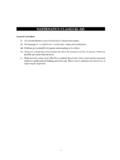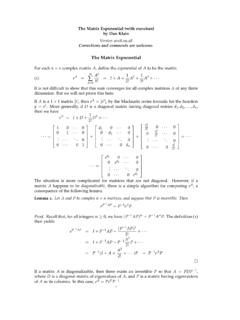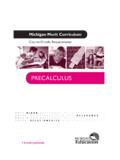Transcription of Michael Spivak - Strange beautiful
1 Michael Spivak Brandeis University Calculus on Manifolds A MODERN APPROACH TO CLASSICAL THEOREMS. OF ADVANCED CALCULUS. ADDISON-WESLEY PUBLISHING COMPANY. The Advanced Book Program Reading, Massachusetts Menlo Park, California New York Don Mills, Ontario Wokingham, England Amsterdam Bonn Sydney Singapore Tokyo Madrid San Juan Paris Seoul Milan Mexico City Taipei Calculus on Manifolds A Modem Approach to Classical Theorems of Advanced Calculus Copyright 1965 by Addison-Wesley Publishing Company All rights reserved Library of Congress Card Catalog Number 66-10910. Manufactured in the United States of America The manuscript was put into production on April 21, 1965;. this volume was published on October 26, 1965. ISBN 0-8053-9021-9. 24 25 26 27 28-CRW-9998979695. Twenty-fourth printing, January 1995. Editors' Foreword Mathematics has been expanding i n all directions at a fabulous rate during the past half century.
2 New fields have emerged, the diffusion into other disciplines has proceeded apace, and our knowledge of the classical areas has grown ever more pro . found . At the same time, one of the most striking trends in modern mathematics is the constantly increasing interrelation . ship between its various branches. Thus the present-day students of mathematics are faced with an immense mountain of material. In addition to the traditional areas of mathe . matics as presented in the traditional manner-and these presentations do abound-there are the new and often en . lightening ways of looking at these traditional areas, and also the vast new areas teeming with potentialities. Much of this new material is scattered indigestibly throughout the research journals, and frequently coherently organized only in the minds or unpublished notes of the working mathematicians.
3 And students desperately need to learn more and more of this material. This series of brief topical booklets has been conceived as a possible means to tackle and hopefully to alleviate some of v vi Editors' Foreword these pedagogical problems. They are being written by active research mathematicians, who can look at the latest develop . ments, who can use these developments to clarify and con . dense the required material , who know what ideas to under . score and what techniques to stress. We hope that they will also serve to present to the able undergraduate an introduction to contemporary research and problems in mathematics, and that they will be sufficiently informal that the personal tastes and attitudes of the leaders in modern mathematics will shine through clearly to the readers. The area of differential geometry is one in which recent developments have effected great changes.
4 That part of differential geometry centered about Stokes' theorem , some . times called the fundamental theorem of multivariate calculus, is traditionally taught in advanced calculus courses (second or third year) and is essential in engineering and physics as well as in several current and important branches of mathematics. However, the teaching of this material has been relatively little affected by these modern developments ; so the mathe . maticians must relearn the material in graduate school , and other scientists are frequently altogether deprived of it. Dr. Spivak 's book should be a help to those who wish to see Stoke ' s theorem as the modern working mathematician sees it. A student with a good course in calculus and linear algebra behind him should find this book quite accessible. Robert Gunning Hugo Rossi Princeton, New Jersey Waltham, Massachusetts August 1965.
5 Preface This little book is especially concerned with those portions of "advanced calculus" in which the subtlety of the concepts and methods makes rigor difficult to attain at an elementary level. The approach taken here uses elementary versions of modern methods found i n sophisticated .mathematics. The formal prerequisites include only a term of linear algebra, a nodding acquaintance with the notation of set theory, and a respectable first-year calculus course (one which at least mentions the least upper bound (sup) and greatest lower bound (inf) of a set of real numbers) . Beyond this a certain (perhaps latent). rapport with abstract mathematics will be found almost essential. The first half of the book covers that simple part of ad . vanced calculus which generalizes elementary calculus to higher dimensions.
6 Chapter 1 contains preliminaries, and Chapters 2 and 3 treat differentiation and integration. The remainder of the book is devoted to the study of curves, surfaces, and higher-dimensional analogues. Here the modern and classical treatments pursue quite different routes ; there are, of course, many points of contact, and a significant encounter vii . VUl Preface occurs in the last section. The very classical equation repro . duced on the cover appears also as the last theorem of the book. This theorem (Stokes' theorem ) has had a curious history and has undergone a striking metamorphosis. The first statement of the theorem appears as a postscript to a letter, dated July 2, , from Sir William Thomson (Lord Kelvin) to Stokes. It appeared publicly as question 8. on the Smith's Prize Examination for 1854. This competitive examination, which was taken annually by the best mathe- , matics students at Cambridge University, was set from 1849 to 1882 by Professor Stokes; by the time of his death the result was known universally as Stokes' theorem .
7 At least three proofs were given by his contemporaries: Thomson published one, another appeared in Thomson and Tait's Treatise on Natural Philosophy, and Maxwell provided another in Elec . tricity and Magnetism [13]. Since this time the name of Stokes has been applied to much more general results, which have figured so prominently in the development of certain parts of mathematics that Stokes ' theorem may be con . sidered a case study in the value of generalization. In this book there are three forms of Stokes' theorem . The version known to Stokes appears in the last section, along with its inseparable companions, Green ' s theorem and the Divergence theorem . These three theorems, the classical theorems of the subtitle, are derived quite easily from a modern Stokes ' theorem which appears earlier in Chapter 5.
8 What the classical theorems state for curves and surfaces, this theorem states for the higher-dimensional analogues (mani . folds) which are studied thoroughly in the first part of Chapter 5. This study of manifolds, which could be justified solely on the basis of their importance in modern mathematics, actually involves no more effort than a careful study of curves and sur . faces alone would require. The reader probably suspects that the modern Stokes'. theorem is at least as difficult as the classical theorems derived from it. On the contrary, it is a very simple con . sequence of yet another version of Stokes ' theorem ; this very abstract version is the final and main result of Chapter 4. Preface ix It is entirely reasonable to suppose that the difficulties so far avoided must be hidden here. Yet the proof of this theorem is, in the mathematician's sense, an utter triviality-a straight.
9 Forward computation. On the other hand, even the statement of this triviality cannot be understood without a horde of difficult definitions from Chapter 4. There are good reasons why the theorems should all be easy and the definitions hard. As the evolution of Stokes ' theorem revealed, a single simple principle can masquerade as several difficult results; the proofs of many theorems involve merely stripping away the disguise. The definitions, on the other hand, serve a twofold purpose: they are rigorous replacements for vague notions, and machinery for elegant proofs. The first two sections of Chapter 4 define precisely, and prove the rules for manipulat . ing, what are classically described as "expressions of the form". P dx + Q dy + R dz, or P dx dy + Q dy dz + R dz dx. Chains, defined in the third section, and partitions of unity (already introduced in Chapter 3) free our proofs from the necessity of chopping manifolds up into small pieces; they reduce questions about manifolds, where everything seems hard , to questions about Euclidean space, where everything is easy.
10 Concentrating the depth of a subject in the definitions is undeniably economical, but it is bound to produce some difficulties for the student. I hope the reader will be encour . aged to learn Chapter 4 thoroughly by the assurance that the results will justify the effort: the classical theorems of the last section represent only a few, and by no means the most im . portant, applications of Chapter 4; many others appear as problems, and further developments will be found by exploring the bibliography. The problems and the bibliography both deserve a few words. Problems appear after every section and are num . bered (like the theorems) within chapters. I have starred those problems whose results are used in the text, but this precaution should be unnecessary-the problems are the most important part of the book, and the reader should at least attempt them all.











